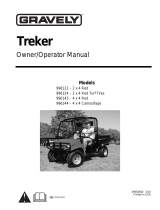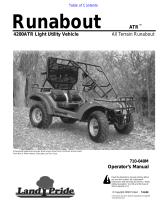
REVISION:
Form No. 3307909.048 5/10
(Replaces 3307909.030)
(French 3309381.006)
©2010 Dometic, LLC
LaGrange, IN 46761
USA
SERVICE OFFICE
Dometic, LLC
2320 Industrial Parkway
Elkhart, IN 46516
574-294-2511
CANADA
Dometic, LLC
46 Zatonski, Unit 3
Brantford, ON N3T 5L8
CANADA
519-720-9578
For Service Center
Assistance Call:
800-544-4881
This manual must be read and
understood before installation,
adjustment, service, or mainte-
nance is performed. This unit must
be installed by a qualied service
technician. Modification of this
product can be extremely hazard-
ous and could result in personal
injury or property damage.
Lire et comprendre ce manuel avant
de procéder à l’installation, à des ré-
glages, de l’entretien ou des répara-
tions. L’installation de cet appareil doit
être effectuée par un réparateur quali-
é. Toute modication de cet appareil
peut être extrêmement dangereuse et
entraîner des blessures ou dommages
matériels.
SUPPLEMENT INSTRUCTIONS MODEL
3307844.005
CONTROL BOX KIT
AND
REMOTE SWITCH

2
WeatherPro Control Box Instructions
AMP 15 Pin MATE-N-LOK® parts required by Install-
er:
(1) 770023-1 Housing
(2) 770246-3 Pin (12-10 gauge)
(11) 770248-1 Pin (20-14 gauge)
AMP 2 Pin MATE-N-LOK® parts required by Installer:
(2) 1-480698-0 Housing
(4) 350547-1 Pin (20-14 gauge) or
640309-3 Pin (10-12 gauge)
AMP 4 Pin MATE-N-LOK® parts required by Installer:
(1) 1-480702-0 Housing
(4) 350690-1 Pin (18-24 gauge)
AMP 4 Pin MATE-N-LOK® parts required by Installer:
(1) 1-480703-0 Housing
(4) 350689-1 Socket (18-24 gauge)
Note: The above Listed Parts are available through
you local electrical supply house.
SAFETY INSTRUCTIONS
This manual has safety information and instruc-
tions to help users eliminate or reduce the risk
of accidents and injuries.
RECOGNIZE SAFETY INFORMATION
This is the safety-alert symbol. When you see this
symbol in this manual, be alert to the potential
for personal injury.
Follow recommended precautions and safe op-
erating instructions.
UNDERSTAND SIGNAL WORDS
A signal word , WARNING OR CAUTION is used
with the safety-alert symbol. They give the level
of risk for potential injury.
indicates a potentially hazard-
ous situation which, if not avoided, could result
in death or serious injury.
indicates a potentially hazard-
ous situation which, if not avoided, may result in
minor or moderate injury.
used without the safety alert
symbol indicates, a potentially hazardous situa-
tion which, if not avoided, may result in property
damage.
Read and follow all safety information and in-
structions.
These instructions must be read and under-
stood before installation of this product. This
product must be installed by a Dometic Ser-
vice Center or a qualied service technician.
Modication of this product can be extremely
hazardous and could result in personal injury
or property damage.
GENERAL INSTRUCTIONS
Pin 1 12+ VDC Red 12 Gauge
Pin 2 12- VDC Black 12 Gauge
Pin 3 Ignition Isolator Pink 16 Gauge
Pin 4 Oasis Elite Remote Switch Green/White 16 Gauge
Pin 5 WeatherPro Remote Switch Green 16 Gauge
Pin 6 Blank
Pin 7 Oasis Elite Motor (-12 VDC) Blue or Blk/Wh See Chart Pg. 3
Pin 8 WeatherPro Motor (-12 VDC) Black See Chart Pg. 3
Pin 9 Oasis Elite Remote Switch Yellow/White 16 Gauge
Pin 10 WeatherPro Remote Switch Yellow 16 Gauge
Pin 11 Blank
Pin 12 Oasis Elite Motor (+12 VDC) Red/White See Chart Pg. 3
Pin 13 WeatherPro Motor (+12 VDC) Red See Chart Pg. 3
Pin 14 Oasis Elite Remote Switch Brown/White 16 Gauge
Pin 15 WeatherPro Remote Switch Brown 16 Gauge
Location Pin Functions Wire Color Wire Size
3307844.005 Automatic Control Box
Kit Wiring
Using AMP UNIVERSAL MATE-N-
LOK® SOFT SHELL CONNECTOR

3
WeatherPro Control Box Instructions
CONTROL BOX KIT (3307844.005)
INSTALLATION
A. Control Box
1. First, decide on a location for the control box.
Recommended locations for the control box are
compartments outside the living quarters such as
one of the basement storage compartments. The
control box must be installed at a location where it
will not be close to steel framing or directly exposed
to weather or extreme temperatures.
2. Mount the control box using four (4) # 6 x 1/2”
screws.
Important: The control box and key fob are pro-
gramed to match each other. They must remain together
as a set.
Wire Length Wire Size
10’ & Under 14 Gauge
11’ to 30’ 12 Gauge
Over 30’ 10 Gauge
AMP UNIVERSAL MATE-N-LOK
Soft Shell Connector
R
13
10
7
4
1
14
8
5
2
15
12
3
11
9
6
Oasis
Elite
FRTA
(12) Red/White
(7) Blue Or Blk/Wh
Red 12VDC + (1)
Black 12VDC - (2)
WeatherPro
Awning
Main Arm
Right Side
(1
3) Red
(8) Black
AMP 2-Pin
Connector
1
2
EXTEND (4) Green/White
NEUTRAL (14) Brown/White
RETRACT (9) Yellow/White Oasis
Elite
Remote
Switch
EXTEND (5) Green
NEUTRAL (15) Brown
RETRACT (10) Yellow
WeatherPro
Remote Switch
(3) Pink
Ignition
Isolator
13
10
7
4
1
14
8
5
2
15
12
3
11
9
6
1
2
EXTEND
RETRACT
Awning
Control
FUSE INSIDE
Black 1
Red 2
Green 3
Yellow 4
Wind Sensor Switch
ENABLE (ON)
DISABLE (OFF)
Cap Female
Cable to Wind Sensor
18-20 Gauge
(18 Foot Maximum)
FIG. 1 B. Connect Control Box to Awning
1. Route two (2) wires (installer supplied) from the
bottom of right side (motorized) arm assembly
(WeatherPro) or FRTA assembly (Oasis Elite) to the
15 pin MATE-N-LOK® connector. To avoid voltage
drop, follow wire length guide listed below:
Use the following 2 Pin AMP MATE-N-LOK® parts
to connect awning connector to wires. See FIG. 1
for pin locations.
(1) 1-480698-0 Housing
(4) 350547-1 Pin (20-14 gauge) or
640309-3 Pin (10-12 gauge)
Important: When installing 8553003 hardware make
sure channel is in proper position before drilling the
hole in side wall for wires. See FIG. 2.
FIG. 2
Top Mounting Bracket
Front
Channel
Back
Channel
Hole For
Cable
Front Channel
Cover
62”
1-3/4”
8553003 Hardware

4
WeatherPro Control Box Instructions
1 Black
2 Red
3Green
4Yellow
When routing harness, take precaution against
wires rubbing on sharp edges and use a grom-
met when going through walls. Harness should
be routed so that when the bottom bracket is
installed (WeatherPro) it will cover hole where
wire goes through wall. Seal any holes with clear
silicon sealant. See FIG. 2.
C. Remote Switch (Installer Supplied)
1. Install the remote switch at a convenient location
such as the door area.
2. The remote switch should not be in direct exposure
to weather or extreme temperatures.
3. Mount switch per manufacturers instructions.
4. Connect the remote switch to the control box by
routing three (3) 16 gauge wires (installer supplied)
from the remote switch to the 15 pin MATE-N-LOK®
connector (Installer Supplied). See FIG. 1 for pin
locations. These wires should be brown, yellow
and green for WeatherPro and brown/white, yel-
low/white and green/white for Oasis Elite. Install
appropriate size insulated terminals on the remote
switch (Installer Supplied) end of wires. Connect
the wires to the remote switch as shown in FIG.
1.
D. Wind Sensor Installation (WeatherPro
Only)
Note: The wind sensor is factory set to operate at a range
of 18 M.P.H., although obstructions on the roof can dimin-
ish the sensors sensitivity. Wind sensor is to be installed
on the RV roof in a vertical position and away from other
objects. It should be located within three (3) feet of the right
side top mounting bracket.
(1) 1-480702-0 Housing
(4) 350690-1 Pin (18-24 gauge)
(1) 1-480703-0 Housing
(4) 350689-1 Socket (18-24 gauge)
3. Connect 6” supplied cable to wind sensor. See
FIG. 3.
4. Connect wind sensor cable to installer supplied
cable. Connect the remaining end to control box
cable and is plugged into the RJ-11 port on the
control box. See FIG. 1.
5. Mount wind sensor to roof with #10 stainless steel
screws (installer supplied). Seal under screw heads
and wind sensor base with suitable sealant to
prevent water leaks.
Important: If vehicle is to be painted after wind sen-
sor is installed, the carousel must be taped off. Wind
sensor will with stand paint booth temperatures up to
185 degree F. The sensor material is Polycarbonate.
Remove tape after painting. See Fig. 3.
E. Low Voltage Connection
1. Disconnect the DC power supply.
FIG. 3
Carousel (Tape Before
Painting)
Wind Sensor
Mounting
Screw
Disconnect the positive (+) 12 volt DC termi-
nal at the supply battery. Damage to equip-
ment could occur if the 12 volt DC is not shut
off.
2. Run two (2) wires from the 12 VDC power supply
source to the 15 pin MATE-N-LOK® connector
(Installer Supplied). See FIG. 1 for pin locations.
It is recommended that these wires be (Red+
and Black -) 12 gauge wires. This should be on a
separate 15 amp circuit.
3. To ensure proper operation, the control box must
have a minimum of 12.5 VDC at the control box
during awning operation. It may be necessary
to increase the wire size if voltage is below 12.5
VDC.
Note: The control box system is protected by a 15 amp
fuse. If needed, a spare 15 amp fuse is taped inside the
control box. Shut off the 12 VDC power to the control box
and remove control box cover to expose fuse inside. Re-
place if necessary.
F. Ignition Interlock Connection
1. Run a 16 gauge wire (installer supplied) from the
Ignition Isolator (+12 VDC) of vehicle to the 15 pin
MATE-N-LOK® connector (installer supplied). See
FIG. 1 for pin location.
2. Connect MATE-N-LOC® connectors together.
Return to Installation Instructions supplied with
hardware to complete the installation.
1. Find wind sensor location and drill 1/2” hole through
roof. See FIG. 3.
2. Route a four (4) conductor 18-20 gauge cable
(maxi- mum length 18’, installer supplied) from
the Wind Sensor to Control Box. Use the following
4 pin MATE-N-LOK® parts to connect the cable to
the control box and wind sensor. See FIG. 1 & 3
for pin locations.
/





